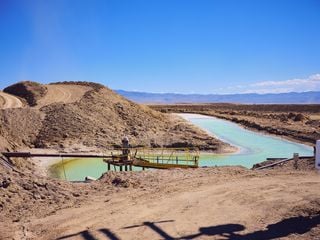Is this the largest battery in the world? NASA warns of its potential
On a bluff hundreds of feet above Lake Michigan sits the Ludington Pumped Storage Plant. We know your way of working and the importance it represents.

The reservoir in the cover image contains something more than water. Located on a cliff hundreds of metres above Lake Michigan, it also stores potential energy that can be released to produce hydroelectric energy. This man-made lake is part of the Ludington Pumping Storage Plant, a hydroelectric pumping storage facility that can be compared to a giant battery, which moves water instead of electrons.
Instead of using complex chemistry, this battery uses simple physics.
The surplus electricity from the grid is used to pump water 110 metres from Lake Michigan to an upper reservoir, which is shown in the image. When the demand for energy is greater, the water goes down again and the pumping turbines rotate in the opposite direction to generate hydroelectric energy.
This image of the installation and the reservoir was taken by OLI (Operational Land Imager) of the Landsat 8 satellite on March 3, 2024.
How does the Ludington Pumping Storage Plant work?
According to NASA's Earth Observatory, the Ludington Pumping Storage Center began operating in 1973, which essentially makes it a battery that continues to work after 50 years. Its upper reservoir is approximately 4 kilometres long and 1.6 kilometres wide. Two spikes and a breakwater protect the outlet and the drain channel from the waves and currents of Lake Michigan, and from April to October, when the ice allows it, a barrier is installed to keep the fish away from the catch.
The water runs through six pumping turbines hidden in sight inside a power plant. According to Consumers Energy, co-owner of the plant, each unit raises or lowers the surface of the reservoir about 30 cm per hour under normal operating conditions. At full capacity, the plant can supply electricity to 1.7 million households.
Michigan electricity comes largely from fossil fuel-powered power plants and nuclear power plants. With these relatively constant sources, the Ludington power plant tends to pump at night when the demand from the network's customers is low, and then goes into hydroelectric mode during the day until its usable capacity is exhausted.
Probable change of operation with the inclusion of renewable energies
That schedule could change as more renewable energy sources are connected in the region. The Ludington power plant could adapt to solar energy, for example, recharging at noon and unloading at night when demand increases, according to analysts. Energy storage on a commercial scale is essential for the widespread adoption of solar and wind energy, since it allows the use of these intermittent sources when sunlight or wind is missing and reduces the need for support plants powered by fossil fuels.
According to the Department of Energy, the United States may need to add hundreds of gigawatts of storage by 2050 to achieve its clean energy goals, and has the potential to at least double the storage capacity by pumping. In 2022, 43 pumped accumulation hydroelectric plants accounted for 96% of U.S. commercial-scale energy storage capacity, although new battery-powered storage facilities increased in 2020-2022. Most of the U.S. pumped accumulation facilities were built between 1960 and 1990, and some, such as Ludington, have been modernized in recent years to increase their capacity and incorporate renewable energy sources.








